What if I told you there was a major story about World War II that hasn't been told, a significant story at the heart of the entire war effort, involving the most unlikely group of heroes you've never heard of? What if I told you there was a group of men on the front lines who quite literally saved the world as we know it; a group that didn't carry machine guns or drive tanks, who weren't official statesmen; men who not only had the vision to understand the grave threat to the greatest cultural and artistic achievements of civilization, but then joined the front lines to do something about it? – Robert M. Edsel, The Monuments Men: Allied Heroes, Nazi Thieves and the Greatest Treasure Hunt in History.
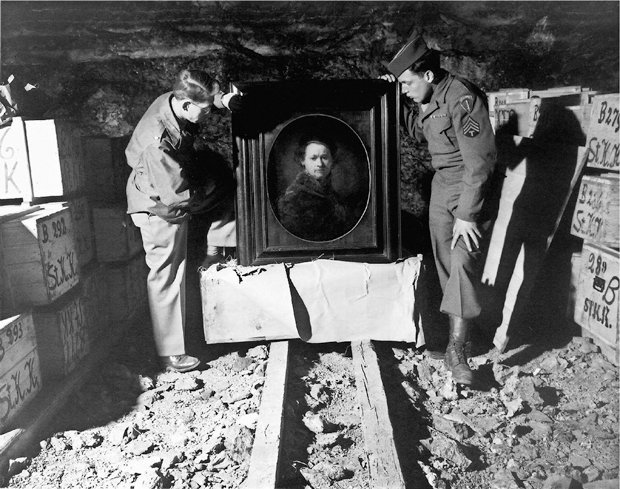 |
| Heilbronn, Germany, 1946: This Self Portrait by Rembrandt, inspected here by Monuments Men Dale V. Ford (left) and Harry Ettlinger (right), was stored for safekeeping by museum officials from Karlsruhe in the Heilbronn mine. |
In the horrific destruction of Europe during World War II, Allied forces chief General Dwight D. Eisenhower issued two unprecedented orders-first in December 1943 and again in May 1944-to save the cultural history and buildings in war areas from combat damage.
The unsung heroes assigned to that monumental task were called the Monuments Men. Today, 70-plus years later, this story has several intriguing local connections to Fort Worth and its own cultural history, including two valuable works of art currently on view at the Kimbell Art Museum.
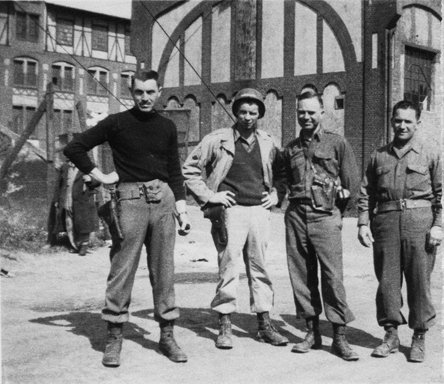 |
| Bernterode, Germany, 1945: Monuments Men George Stout (left), Walker Hancock (center right) and Steven Kovalyak (right) during the excavation of Bernterode. Sgt. Traverse stands between Stout and Hancock. |
The Monuments Men were a group of approximately 350 men and women from 13 nations, who served in the Western Allied military effort from 1943 until 1951. Most were volunteers in the newly created Monuments, Fine Arts and Archives (MFAA) section, and many were experienced as museum directors, curators, art historians, artists, architects and educators. The group was proposed by a commission established by President Franklin D. Roosevelt in 1943.
Originally, their job was to protect monuments and other cultural treasures from damage. In the final year of the war, the focus shifted, as they tracked, located and, in the years that followed, returned more than 5 million artistic and cultural items stolen by Hitler and the Nazis. Many of these priceless paintings and sculptures were destined for the Führermuseum, an unrealized museum complex planned by Hitler for the Austrian city of Linz, to display his collection of plundered or stolen art.
The Monuments Men remained in Europe following the war to oversee the complicated restitution of the stolen works of art. Upon returning home, several had important roles in building some of the greatest cultural and educational institutions in the United States. They became directors, curators, trustees and advisers of world-renowned museums, including the Met, the MOMA, the National Gallery of Art and two Fort Worth museums, the Amon Carter Museum of American Art and the Kimbell Art Museum.
Upon the death of art patron Kay Kimbell in 1964, Monuments Man James Rorimer was asked to advise the Kimbell Art Foundation on proceeding with Kay Kimbell's directive to build an art museum "of the first class" in Fort Worth.
Monuments Men Charles Parkhurst and Harry Grier (past director of the Frick Museum) both served as trustees for the Amon Carter.
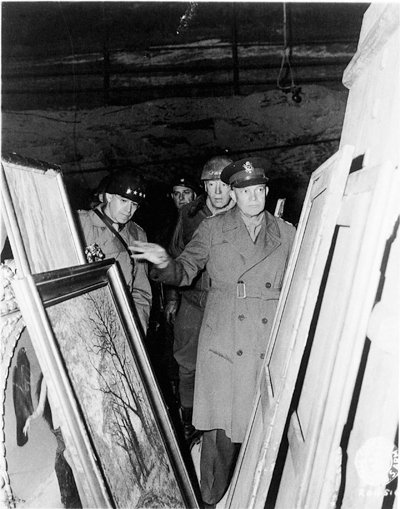 |
| Merkers, Germany, 1945: Lt. Gen. Omar N. Bradley, Lt. Gen. George S. Patton Jr. and Gen. Dwight D. Eisenhower inspect the German museum treasures stored in the Merkers mine. Pictured in the center is Maj. Irving Leonard Moskowitz. |
The Monuments Men are no longer unsung heroes, due to the efforts of Robert M. Edsel, a passionate and determined North Texan, former nationally ranked tennis player and oil and gas businessman, who has spent the last 10 years of his life on a journey, researching and writing about these heroes and continuing their work.
After selling his oil and gas business in 1996, Edsel moved his wife and two-year-old son to Europe, settling in Florence, Italy. He was 39 years old and had no plans, he says. "I had success, was a little bit ahead in 16 years of taking enormous risks, and I had reached a moment where I wanted something more meaningful. I didn't have anything in mind but felt if I didn't find my way off the merry-go-round and declare a time-out, I'd never have a chance to find anything."
Edsel began to study art and architecture in Florence. One day, he was crossing the city's famous medieval covered bridge, the Ponte Vecchio-the only bridge in the city that was not destroyed by the Nazis in August 1944.
"I wondered how, during the most destructive conflict in history, so many cultural objects and works of art survived, and who were the people that saved them," Edsel says. "I was embarrassed that I didn't know the answer but was hugely embarrassed that I hadn't asked the question."
Eventually, he found the answer and his life's mission: to honor and continue the work of the Monuments Men.
Edsel founded the Monuments Men Foundation for the Preservation of Art in 2007. General Eisenhower's granddaughter, Susan Eisenhower, serves on the Foundation's advisory board.
Edsel has authored three books: Saving Italy: The Race to Rescue a Nation's Treasures from the Nazis; Rescuing Da Vinci: Hitler and the Nazis Stole Europe's Great Art-America and Her Allies Recovered It; and The Monuments Men: Allied Heroes, Nazi Thieves and the Greatest Treasure Hunt in History. Edsel is also the co-producer of the documentary film, The Rape of Europa, based on the award-winning book of the same name by scholar Lynn Nicholas.
The Monuments Men Foundation plays an active role encouraging institutions and individuals, in the United States and abroad, to know about the wartime whereabouts of objects in their collection in accord with the American Association of Museum's guidelines concerning Nazi-era provenance (history of ownership).
Research into provenance of works of art in its collection has always been part of the Kimbell's mission. In recent years, as interest in this aspect of art history has grown, the museum has doubled its efforts in this area. The museum pays particular attention to changes in ownership during the Nazi era from 1933 to 1945.
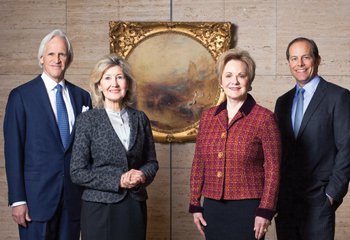 |
 |
| (top, left to right) Author Robert M. Edsel; U.S. Sen. Kay Bailey Hutchison; U.S. Rep. Kay Granger; Kimbell Art Museum Director Dr. Eric Lee with Joseph Mallord William Turner's Glaucus and Scylla. (bottom, left to right) Dr. Eric Lee; Dr. Nancy Edwards, curator of European art at the Kimbell; Robert M. Edsel with the Isabella d'Este Renaissance bust. |
In 2006, in light of the evidence linking Joseph Mallord William Turner's painting Glaucus and Scylla (1841) to an unlawful seizure by the Nazi Vichy Regime in France in 1943, the Kimbell Art Museum returned the painting to the heirs of John and Anna Jaffe. The painting had been in the Kimbell's collection since 1966. The museum repurchased the Turner art at Christy's New York the following year for $5.7 million.
"It's important for any museum to be as transparent as possible," said Dr. Eric Lee, director of the Kimbell. "There's been greater awareness with issues involving provenance since the mid-to-late 1990s, and there's been a lot of attention focused on works of art during World War II when much had been looted," "This has continued to be a critical issue, and Robert Edsel has brought much attention to it. It's important that all museums maintain strict ethical standards and that the public has trust in the institutions."
In 2011, the Kimbell announced the discovery of a photograph confirming that a Renaissance portrait bust in its collection was in the Altaussee Salt Mine in Austria. This mine was one of many repositories for artwork stolen by the Nazis.
Edsel discovered the photograph and showed it to Lee. Acquired by the Kimbell in 2004, the bust is traditionally identified as a portrait of Isabella d"Este (1474-1539), one of the most celebrated women in Renaissance Italy. The work is attributed to the sculptor Gian Cristoforo Romano, but that has not been proven, Lee said.
After two years of provenance by Dr. Nancy Edwards, curator of European art at the Kimbell, documentation was found to prove that the work had been properly purchased.
"Whenever anything is in private ownership, there may be little written about it," Edwards said. "We were able to trace that the bust was part of a collection that went to Hitler. We were able to trace it through all the documents that the Germans kept and that the Monuments Men kept, so we know where it went, which salt mine it was in, how it was restituted and how it was sent back to the Netherlands."
The museum has not jumped to the conclusion that the bust was destined for Hitler's museum, Lee said. "It may have been, but we stop short of saying that. We don't have proof because not everything in the salt mine was destined for his museum," Lee said. "It's been attributed to Romano. He may or may not have done it. There's a strong possibility that it's a bust of Isabella d"este. What we know for sure is that it's a masterpiece. Testing in the 1970s proved that without question that it was made during the Renaissance."
"We were proud to work with Dr. Lee, Dr. Edwards and the Kimbell," Edsel said. "The Kimbell Art Museum once again handled a Nazi-era provenance case in the most exemplary manner."
Edsel said that the Monuments Men Foundation has "three angels that have helped us along the way in getting some visibility, and they've all been named Kay-Kay Fortson, who introduced me to U.S. Congresswoman Kay Granger and U.S. Senator Kay Bailey Hutchison, at one of the dinners at the Kimbell in 2006," Edsel said. His first book, Rescuing Da Vinci, had just been published.
"Kay Granger asked, "How can I help?" Those were hugely important words because that led to us getting a Congressional Resolution, which is important, but far easier to accomplish than the Congressional Gold Medal. Kay Bailey Hutchison supported efforts in the Senate. So, these three women, each accomplished in their own way, were very early supporters in the foundation's purpose. These are leaders that lead. Kay Granger has been our champion in the halls of Congress in seeing that these men got the recognition they deserved," he said. "It's taken a lot of shoe leather, but she's been there."
On Dec. 5, 2013, Rep. Granger introduced H.R. 3658, The Monuments Men Recognition Act of 2013. The bipartisan legislation would honor the Monuments Men of World War II with the Congressional Gold Medal.
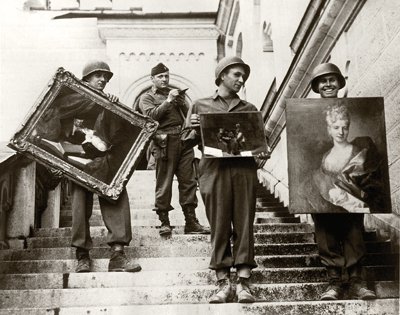 |
| At the same time Adolf Hitler was attempting to take over the western world, his armies were methodically seeking and hoarding the finest art in Europe. A special force of American and British museum directors, curators, art historians and others, called the Monuments Men, risked their lives to prevent the destruction of thousands of years of culture. |
"What a change in direction for a country to say, "to the victor go the spoils,"" Granger said. "I knew nothing about the Monuments Men until that dinner in 2006, and I was absolutely fascinated when Robert told me about these heroes. It's an honor to be able to work on this, especially in trying to get the Congressional Medal, but it really has been fascinating to me because I've loved art my entire life. I paint and I live right across the street from the Kimbell Art Museum. This is an international story, and it's fun to have the Fort Worth connection. Sometimes, when stolen art from the Nazis is discovered in museums, there are court battles that go on for years with the families. That was not the situation with the Kimbell. They've set the standard for how these works of art should be handled. Of that, Fort Worth should be very proud."
Sen. Hutchison says that the Monuments Men deserve to be honored because their efforts show another facet of the greatness of America. "Robert Edsel deserves all the credit for not giving up," she said. "His work was a huge undertaking. As their story is being told, people will see a magnanimous side of the American military that they won't see anywhere else."
There have been many feature films about the events and heroes of World War II, but never a feature film about the Monuments Men-until now.
The Monuments Men, directed by and starring George Clooney, premieres around the world beginning in the United States on Feb. 7. The movie includes a stellar cast of the world's most accomplished actors including Matt Damon, Cate Blanchett, John Goodman, Bill Murray, Jean Dujardin and Hugh Bonneville.
The Kimbell Art Museum hosted two special screenings on Jan. 19.
"This film will show people around the world something that our country had a leadership role in, and it saved so much of the beauty and history of the world as we know it," Edsel said. "It's a great credit to our leaders, Gen. Eisenhower, President Roosevelt and the Monuments Men and Women. It's also a great testament to the Kays and others who have understood what kind of world we might be living in without the work of these heroes."
On June 6, 2007, the United States government officially recognized the contributions of the Monuments Men during World War II in the protection of artistic and cultural treasures by passing resolutions in both the House and Senate in their honor. At that time, four of the 12 living Monuments Men were able to attend: Bernard Taper, James Reeds, Harry Ettlinger and Horace Apgar. Numerous family members of other Monuments Men attended. Of particular note were the 10 Ambassadors or Chargés d"Affaires in attendance from the 12 other nations from which Monuments Men hailed. It was truly an international event.
Only five - four men and one woman - are still alive today.
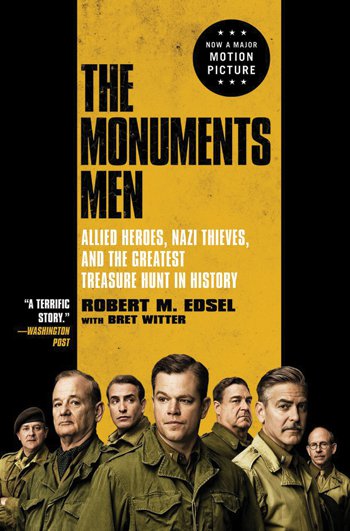 On Jan. 19, the Kimbell Art Museum hosted a special advanced screening of the highly anticipated new film The Monuments Men, directed by George Clooney from a screenplay by George Clooney and Grant Heslov. The movie is based on the best-selling book of the same title by Robert M. Edsel with Bret Witter and will be officially released in theaters nationwide on Feb. 7. This was the first film shown in the Kimbell's new concrete and glass Renzo Piano Pavilion auditorium.
On Jan. 19, the Kimbell Art Museum hosted a special advanced screening of the highly anticipated new film The Monuments Men, directed by George Clooney from a screenplay by George Clooney and Grant Heslov. The movie is based on the best-selling book of the same title by Robert M. Edsel with Bret Witter and will be officially released in theaters nationwide on Feb. 7. This was the first film shown in the Kimbell's new concrete and glass Renzo Piano Pavilion auditorium.
Based on the true story of the greatest treasure hunt in history, The Monuments Men is an action drama focusing on seven over-the-hill, out-of-shape museum directors, artists, architects, curators and art historians who went to the front lines of WWII to rescue the world's artistic masterpieces from Nazi thieves and return them to their rightful owners.
"The looting and destruction that occurred during World War II could have had an even more devastating impact on the art and architecture of Europe, some of which now resides in the Kimbell Art Museum," said Eric M. Lee, the museum's director. "It is due to the foresight and heroism of the Monuments Men that so many treasures survive today. We couldn't be more thrilled to be selected to screen the film and to support my friend and colleague Robert Edsel and the Monuments Men Foundation."
Said Edsel: "We are very excited that our film about these heroes of civilization was screened in such a prestigious and beautiful setting as the Kimbell Art Museum. The Kimbell has an important connection to this story: Several works of art stolen by the Nazis and later recovered by the Monuments Men are now a part of its permanent collection. In addition, several former Monuments Officers, including James Rorimer, advised the Kimbell Art Foundation in the early days of planning for the museum."
Proceeds from the screening benefit the Monuments Men Foundation.
The Monuments Men (110 minutes), presented by Columbia Pictures and Fox 2000 Pictures, is directed by and stars George Clooney. It also stars Matt Damon, Bill Murray, John Goodman, Jean DuJardin, Bob Balaban Hugh Bonneville and Cate Blanchett. The screenplay is by George Clooney and Grant Heslov. Produced by Grant Heslov and George Clooney.
Monuments Men Foundation
The Monuments Men Foundation honors the legacy of the men and women who served in the Monuments, Fine Arts and Archives section, known as the "Monuments Men," and their unprecedented and heroic work protecting and safeguarding civilization's most important artistic and cultural treasures from armed conflict during World War II. Raising public awareness is essential to the Foundation's mission. Monumentsmenfoundation.org

